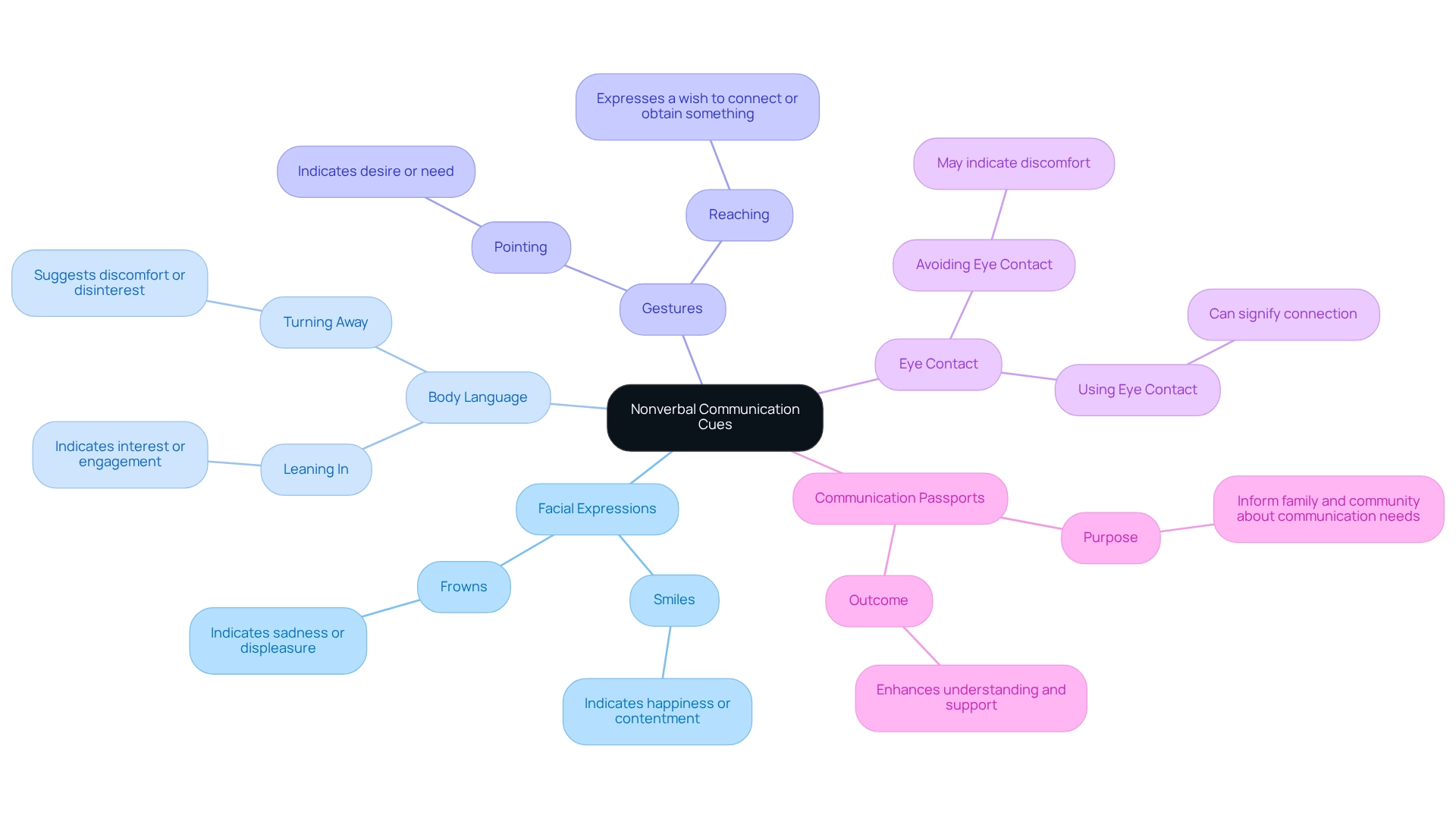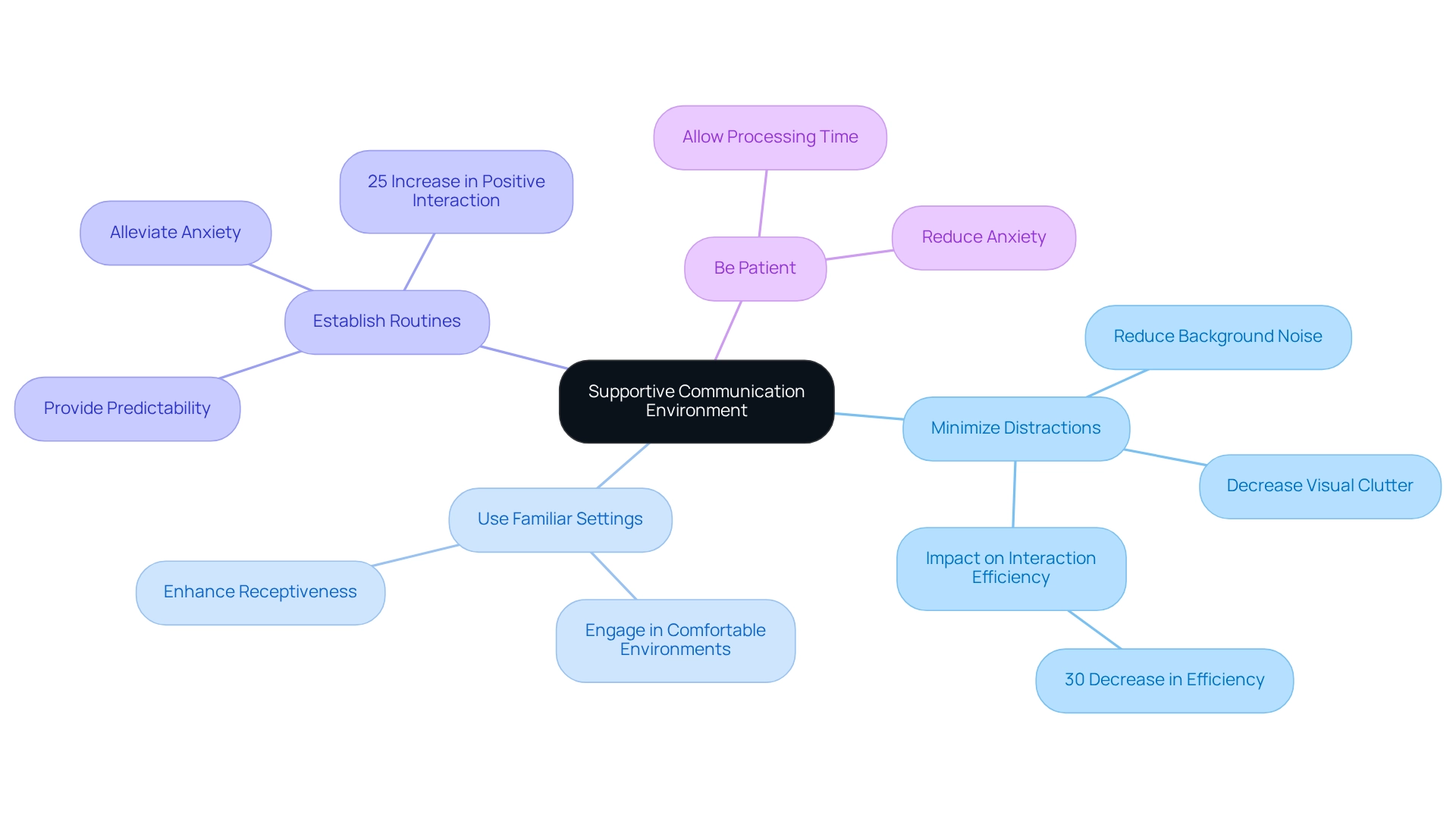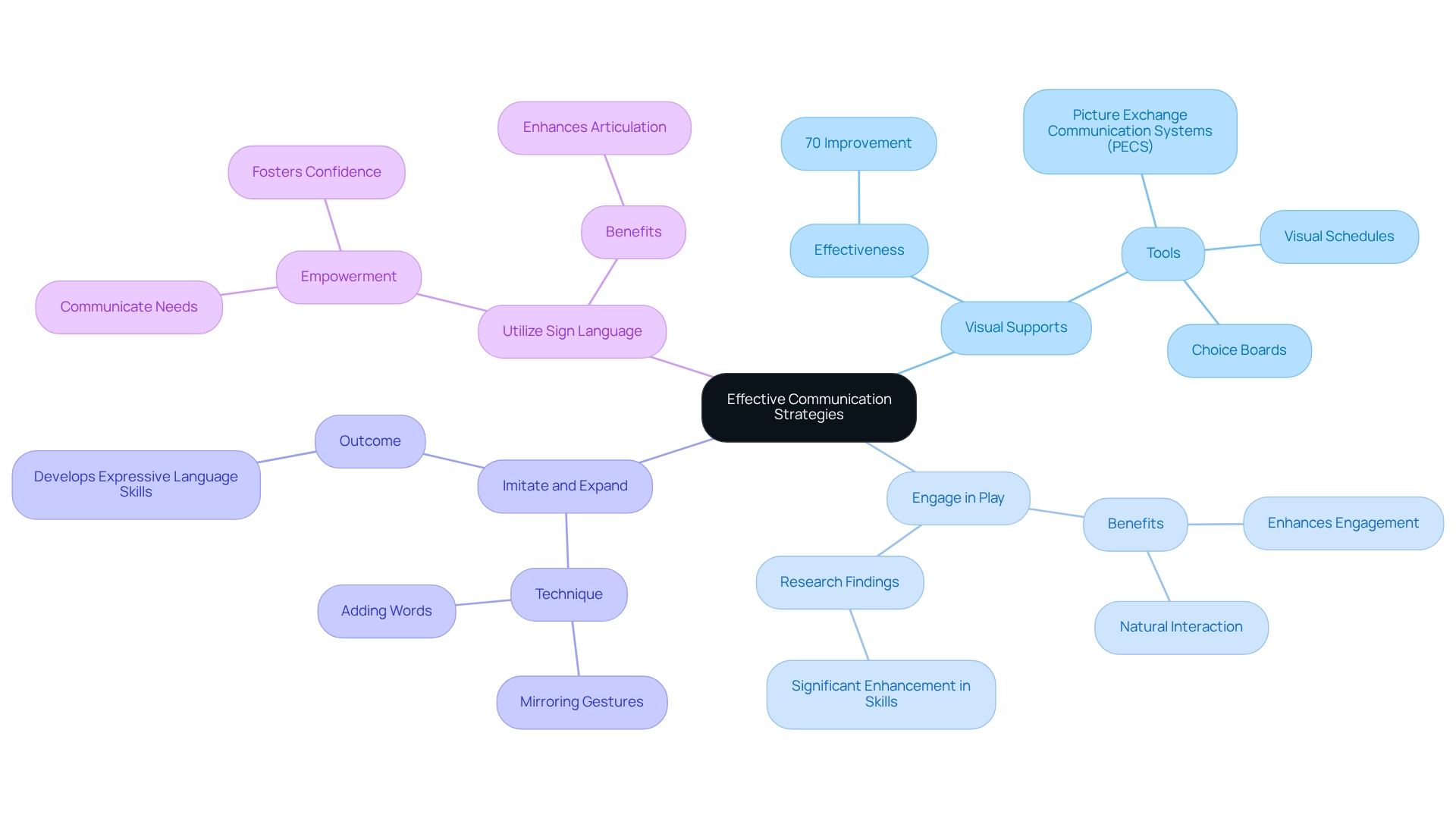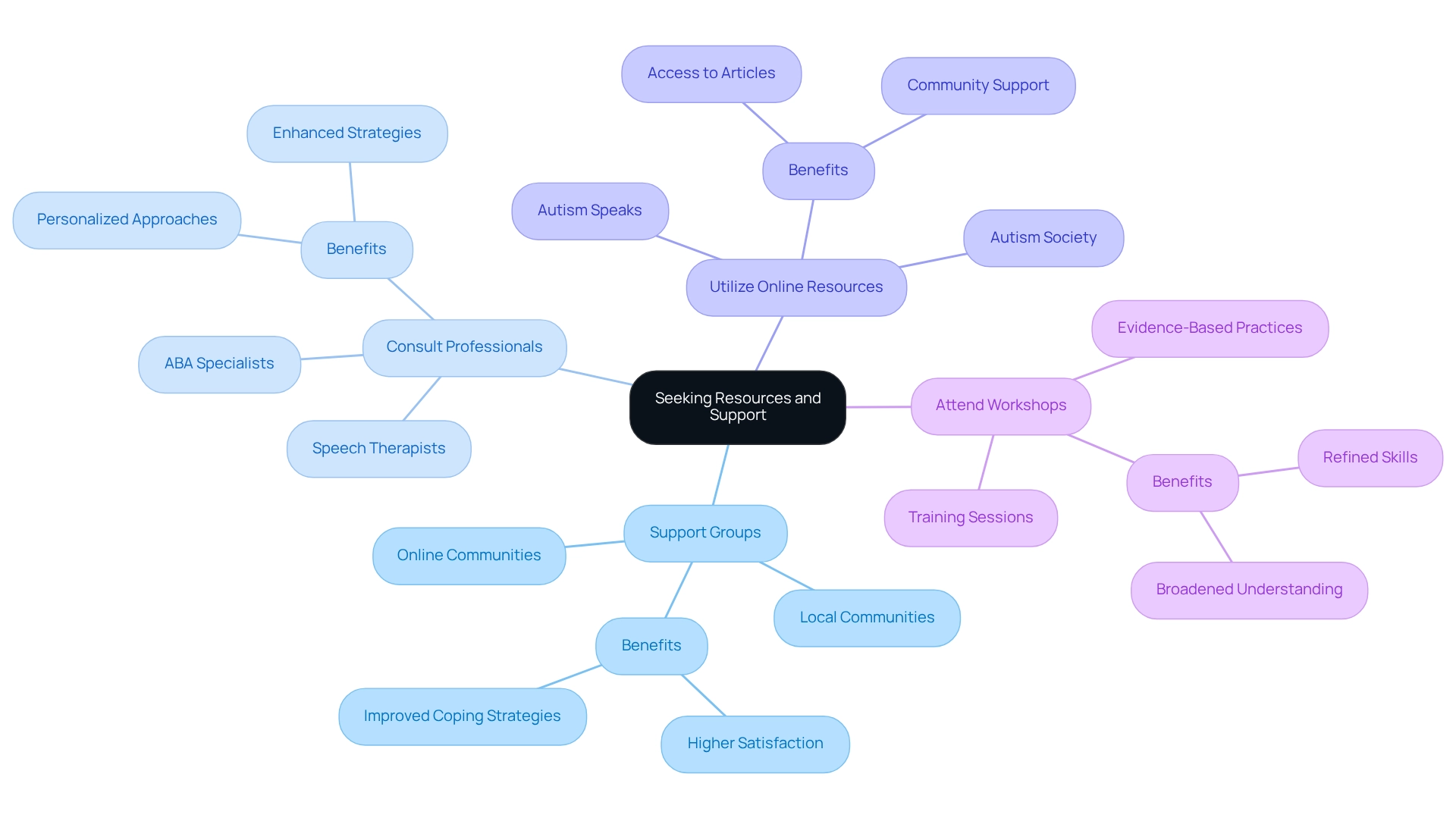Overview
To effectively communicate with a nonverbal autistic child, caregivers are encouraged to focus on understanding nonverbal cues. This starts with creating a supportive environment and implementing tailored communication strategies.
By observing the following, caregivers can gain valuable insights:
- Facial expressions
- Body language
- Gestures
Minimizing distractions and utilizing visual supports further fosters a nurturing atmosphere. These approaches not only enhance empathetic interactions but also empower the child to express themselves more freely.
Together, we can cultivate a deeper understanding and connection, making a significant difference in the child's ability to communicate.
Introduction
Navigating the world of communication with nonverbal autistic children is a journey filled with both challenges and rewards. Understanding their unique ways of expressing needs and emotions is essential for fostering meaningful interactions. Caregivers play a vital role in bridging the communication gap, from interpreting subtle facial expressions to recognizing body language and gestures.
By creating a supportive environment and implementing effective strategies—such as utilizing visual aids and engaging in play—caregivers can significantly enhance their connections with these children. This article explores practical approaches and resources designed to empower families, ensuring that every child’s voice is heard and understood.
Understand Nonverbal Communication Cues
Effective interaction with a nonverbal autistic child involves understanding how to communicate with a nonverbal autistic child by gently observing their nonverbal signals, which can reveal their needs and feelings. It's vital to focus on key areas:
- Facial Expressions: Take note of various expressions, such as smiles or frowns, which can convey a multitude of feelings. Research underscores the importance of recognizing these subtle signals, as they are crucial for understanding emotional states.
- Body Language: Observe how the child positions their body. For instance, leaning in may indicate interest or engagement, while turning away could suggest discomfort or disinterest. Understanding how to communicate with a nonverbal autistic child can significantly enhance interaction through these physical signals.
- Gestures: Look for hand movements, pointing, or reaching, which often indicate desires or needs. These gestures serve as essential means of expression, facilitating a connection between verbal and nonverbal interactions.
- Eye Contact: Some young individuals may avoid eye contact, while others may use it to connect. Understanding how to communicate with a nonverbal autistic child regarding their comfort level with eye contact is essential for creating a supportive interaction environment.
Integrating tools like communication passports can further enhance understanding and support from family and the community, ensuring that a young person's unique way of expressing themselves is acknowledged and accommodated. As stated by Boston Children's Hospital's Autism Language Program, which serves approximately 1,500 children with autism annually, understanding how to communicate with a nonverbal autistic child is crucial for successful interaction. One anonymous individual beautifully expressed, "I may have autism, but it’s just one aspect of who I am. It does not define me." This sentiment highlights the uniqueness of children on the spectrum and the importance of recognizing their distinct ways of communicating. By tuning into these cues, caregivers can cultivate a more responsive and empathetic environment for interaction, ultimately enriching relationships.

Create a Supportive Communication Environment
Creating a nurturing dialogue atmosphere is vital for understanding how to communicate with a nonverbal autistic child. This approach not only supports how to communicate with a nonverbal autistic child but also addresses the emotional needs of both the child and the parent. Here are some key strategies to consider:
- Minimize Distractions: Reducing background noise and visual clutter is crucial. Distractions can significantly impede interaction, making it challenging for young individuals to concentrate on exchanges. Research indicates that distractions can decrease interaction efficiency by as much as 30% in children on the spectrum. Imagine trying to have an important conversation in a noisy room—it's tough!
- Use Familiar Settings: Engaging in interactions within familiar environments, such as their bedroom or a favorite play area, can enhance comfort and receptiveness. When children feel secure and less anxious in familiar surroundings, their ability to engage increases. Picture how much easier it is to talk when you’re in a space that feels like home.
- Establish Routines: Consistent routines provide predictability, helping children anticipate interactions and feel more secure. This structure can alleviate anxiety and encourage engagement during interaction. According to the U.S. Department of Education, students with autism who have established routines are 25% more likely to engage in positive interaction behaviors. Think about how comforting it is to know what comes next in your day.
- Be Patient: Allowing ample time for your young one to process information and respond is essential. Rushing can increase anxiety and hinder effective communication. As autism experts remind us, "Patience is crucial; allowing youngsters the time they require can greatly enhance their capacity to communicate."
Furthermore, the Autism Partner Toolkit offers valuable resources for parents and professionals aiming to implement these strategies effectively. By integrating these approaches, you can create an environment that not only teaches you how to communicate with a nonverbal autistic child but also nurtures a sense of safety and ease for your child. This, in turn, can significantly improve their ability to articulate themselves. Remember, every small step you take is a step towards better communication and connection.

Implement Effective Communication Strategies
To implement effective communication strategies, consider these nurturing approaches:
- Use Visual Supports: Incorporate pictures, symbols, or written words to convey messages. Tools such as Picture Exchange Communication Systems (PECS) have shown remarkable effectiveness, with parents noting enhancements in their children's ability to express themselves by up to 70% when visual supports are utilized. This statistic underscores the importance of visual aids in improving interaction.
- Engage in Play: Embrace play as a means for expression. Activities that capture your child's interest can motivate them to convey themselves through actions and gestures, nurturing a natural interaction environment. Research indicates that play can significantly enhance engagement and interaction skills in nonverbal autistic youth, making it an essential approach.
- Imitate and Expand: When your little one uses gestures or sounds, mirror them to demonstrate understanding. Gradually expand their interactions by adding words or phrases, which can aid in developing their expressive language skills.
- Utilize Sign Language: Teaching basic sign language can empower your child to communicate their needs and feelings effectively. This method not only enhances their ability to articulate but also fosters confidence in their verbal skills.
These strategies can profoundly enhance your ability to connect with your child, particularly in understanding how to communicate with a nonverbal autistic child, fostering a more interactive and communicative relationship. A recent study on the feasibility of home visual support interventions highlighted the practicality and acceptability of such resources, indicating that families benefit from structured approaches tailored to their specific needs. The research revealed that tools like visual schedules and choice boards were particularly beneficial in improving interaction outcomes. As Marion Rutherford emphasizes, "Parents provide positive feedback when they have access to a variety of resources relevant to different developmental stages," highlighting the importance of diverse tools for effective communication with nonverbal individuals on the spectrum.

Seek Resources and Professional Support
- Join Support Groups: Connecting with local or online support groups for parents of autistic children can be incredibly valuable. Many parents who engage in these communities report higher levels of satisfaction and improved coping strategies. By sharing experiences, you foster a sense of belonging and gain insights that can encourage and empower you throughout your journey.
- Consult Professionals: Collaborate with speech therapists or ABA specialists who can offer personalized approaches tailored to your child's unique needs. Research shows that expert guidance significantly enhances strategies for children with autism. For instance, a recent case study highlighted parents' positive feedback on using video modeling to improve self-help skills in their children, suggesting it as a promising intervention.
- Utilize Online Resources: Take advantage of dedicated websites and forums, such as Autism Speaks and the Autism Society, which provide a wealth of articles, toolkits, and community support. These resources can assist you in navigating the complexities of autism support.
- Attend Workshops: Participate in workshops or training sessions focused on autism interaction strategies. These experiences not only refine your skills but also broaden your understanding of effective interventions. As Marcus Fuller pointed out, evidence-based practices are essential for teaching academic skills to students with ASD, highlighting the importance of seeking professional guidance.
Actively pursuing resources and support empowers both you and your child, fostering a more effective communication dynamic and enhancing overall outcomes.

Conclusion
Understanding and effectively communicating with nonverbal autistic children is a journey that requires a multifaceted approach, one that emphasizes observation, patience, and the creation of a supportive environment. By recognizing and interpreting nonverbal cues such as facial expressions, body language, gestures, and eye contact, caregivers can forge a deeper connection with these children, gaining insight into their needs and emotions.
Establishing a nurturing communication environment is equally essential. By minimizing distractions, using familiar settings, and maintaining consistent routines, caregivers can enhance a child's comfort and willingness to engage. Implementing effective communication strategies—like visual supports and play-based interactions—empowers children to express themselves, fostering a more dynamic and meaningful relationship.
Additionally, actively seeking resources and professional support can provide invaluable assistance. Engaging with support groups, consulting professionals, and utilizing online resources equips caregivers with the tools and strategies necessary to navigate the complexities of communication with nonverbal autistic children.
Ultimately, fostering meaningful interactions hinges on understanding and adapting to each child's unique communication style. By embracing these strategies and creating an inclusive environment, caregivers can ensure that every child's voice is recognized, valued, and understood. This paves the way for deeper connections and enhanced emotional well-being, inviting caregivers to share their experiences and learn from one another in this rewarding journey.
Frequently Asked Questions
How can I effectively interact with a nonverbal autistic child?
Effective interaction involves gently observing the child's nonverbal signals, which can reveal their needs and feelings. Key areas to focus on include facial expressions, body language, gestures, and eye contact.
What should I observe in a nonverbal autistic child's facial expressions?
Take note of various expressions, such as smiles or frowns, as they can convey a multitude of feelings. Recognizing these subtle signals is crucial for understanding their emotional states.
How does body language play a role in communication with a nonverbal autistic child?
Observing body positioning is essential; for instance, leaning in may indicate interest, while turning away could suggest discomfort or disinterest. Understanding these physical signals can significantly enhance interaction.
What types of gestures should I look for when communicating with a nonverbal autistic child?
Look for hand movements, pointing, or reaching, which often indicate desires or needs. These gestures are essential means of expression and facilitate a connection between verbal and nonverbal interactions.
Is eye contact important when interacting with a nonverbal autistic child?
Yes, understanding the child's comfort level with eye contact is essential. Some may avoid it while others may use it to connect, and recognizing this can help create a supportive interaction environment.
How can tools like communication passports assist in understanding nonverbal autistic children?
Communication passports can enhance understanding and support from family and the community, ensuring that the child's unique way of expressing themselves is acknowledged and accommodated.
Why is it important to understand how to communicate with a nonverbal autistic child?
Understanding how to communicate is crucial for successful interaction, as it helps caregivers cultivate a more responsive and empathetic environment, ultimately enriching relationships.




